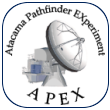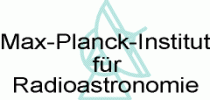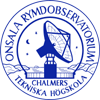APEX News and updates
|
| The APEX Safety Plan and Safety Regulations have been reviewed and updated during the past months. The documents are now available under the Safety section of our web page. |
|
| Check online the ESO Messenger issue n. 176, which includes an article about the excellent data collected as part of the new facility SEPIA660 instrument Science Verification. The article is called "Orion-KL Observations with the Extended Tuning Range of the New SEPIA660 APEX Facility Instrument". You can access it online through the ESO Messenger web pages. |
|
|
The Chamber of Deputies of Chile offered a tribute to astronomers and observatories in Chile involved in the observations of the Black Hole in Messier 87. A delegation with staff from Universidad de Concepción, APEX and ALMA were present in this ceremony, where the deputies congratulated the teams involved in this discovery and highlighted the role of astronomy in Chile.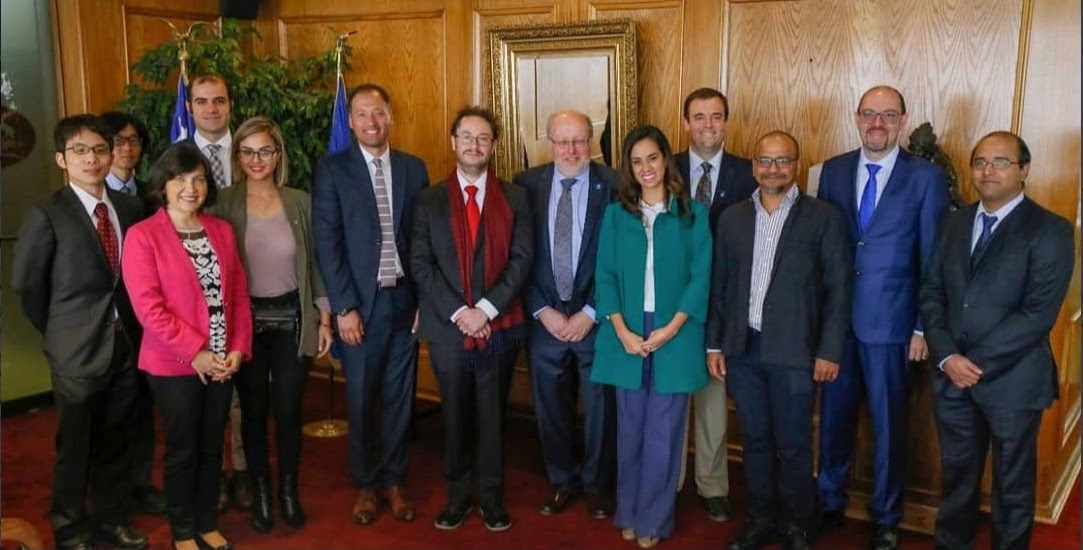 |
|
|
ESO Science Release 1907.
Astronomers Capture First Image of a Black Hole. ESO, ALMA, and APEX contribute to paradigm-shifting observations of the gargantuan black hole at the heart of the galaxy Messier 87. Congratulations to the EHT team for this outstanding achievement! Check the press conference with some explanations about the amazing image released in this page 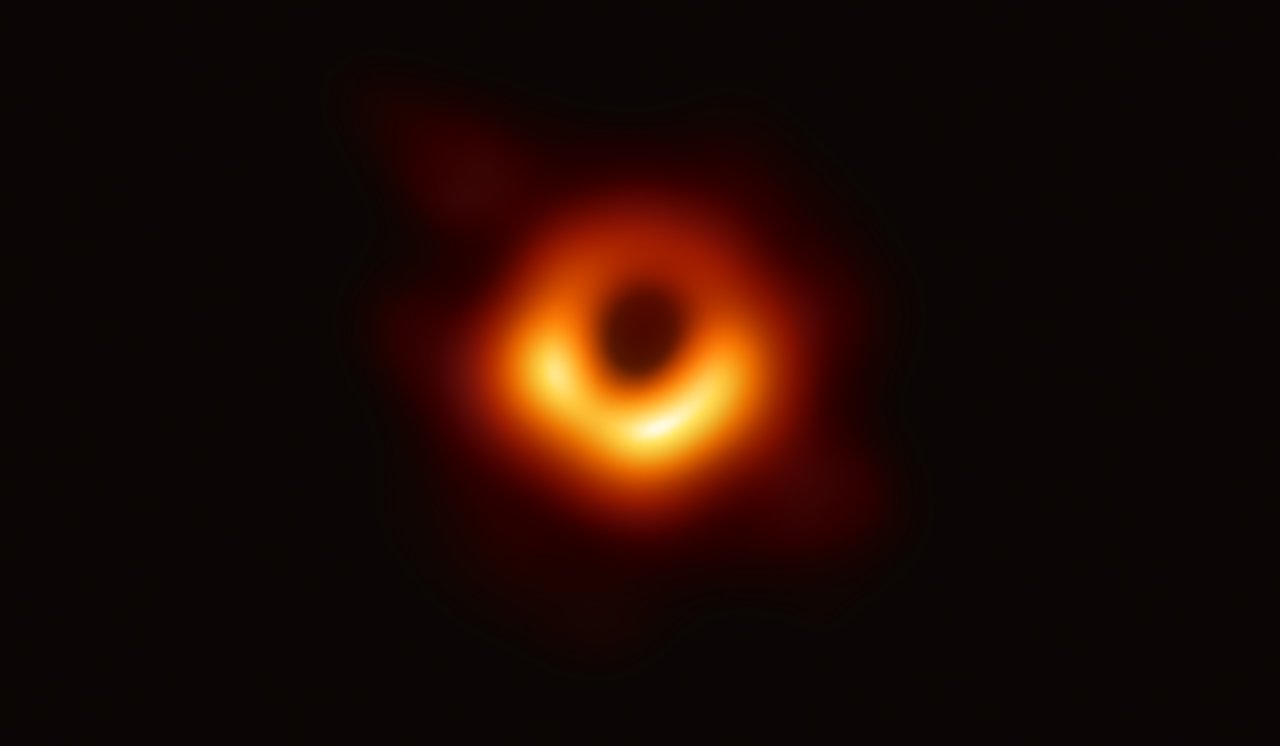 Image credit: EHT collaboration. |
|
|
ESO Science Release 1812.
ALMA and APEX discover massive conglomerations of forming galaxies in early Universe. The ALMA and APEX telescopes have peered deep into space - back to the time when the Universe was one tenth of its current age - and witnessed the beginnings of gargantuan cosmic pileups: the impending collisions of young, starburst galaxies. Astronomers thought that these events occurred around three billion years after the Big Bang, so they were surprised when the new observations revealed them happening when the Universe was only half that age! These ancient systems of galaxies are thought to be building the most massive structures in the known Universe: galaxy clusters. |
|
| New ArTeMiS IDL Pipeline is now available here. |
|
| As from January 1st, Lars-Ake Nyman returns back to APEX as Station Manager. He comes back with the experience of several years being the Head of ALMA Science Operations. Welcome back Lars-Ake. |
|
| Thomas Klein is leaving APEX by the end of the year and will be leading the Project Coordination Office at La Silla-Paranal Observatory. Congratulations and all the best in your new responsibility. |
|
| After more than 13 years onboard, Michael Dumke leaves the Sciops group seeking for new personal and proffessional horizons. Good luck with your future projects, Michael. |
|
| It is now available in Astronomy and Astrophysics the paper describing the SEDIGISM (Structure, Excitation, and Dynamics of the Inner Galactic InterStellar Medium) survey and the first results in the science demonstration field. You can access it here. |
|
| The APEX Low-redshift Legacy Survey for MOlecular Gas (ALLSMOG, PI Jeff Wagg) has observed the CO(2-1) line in a sample of 88 galaxies in the Local Universe (0.01 < z < 0.03). The ALLSMOG observations add information on cold molecular gas content of all sources in this sample and the spectra are available in the ALLSMOG Phase 3 release. |
|
|
The partners of the Atacama Pathfinder Experiment (APEX) have signed an extension of the agreement, ensuring that this very productive collaboration will continue until the end of 2022.
Read more in the ESO official announcement
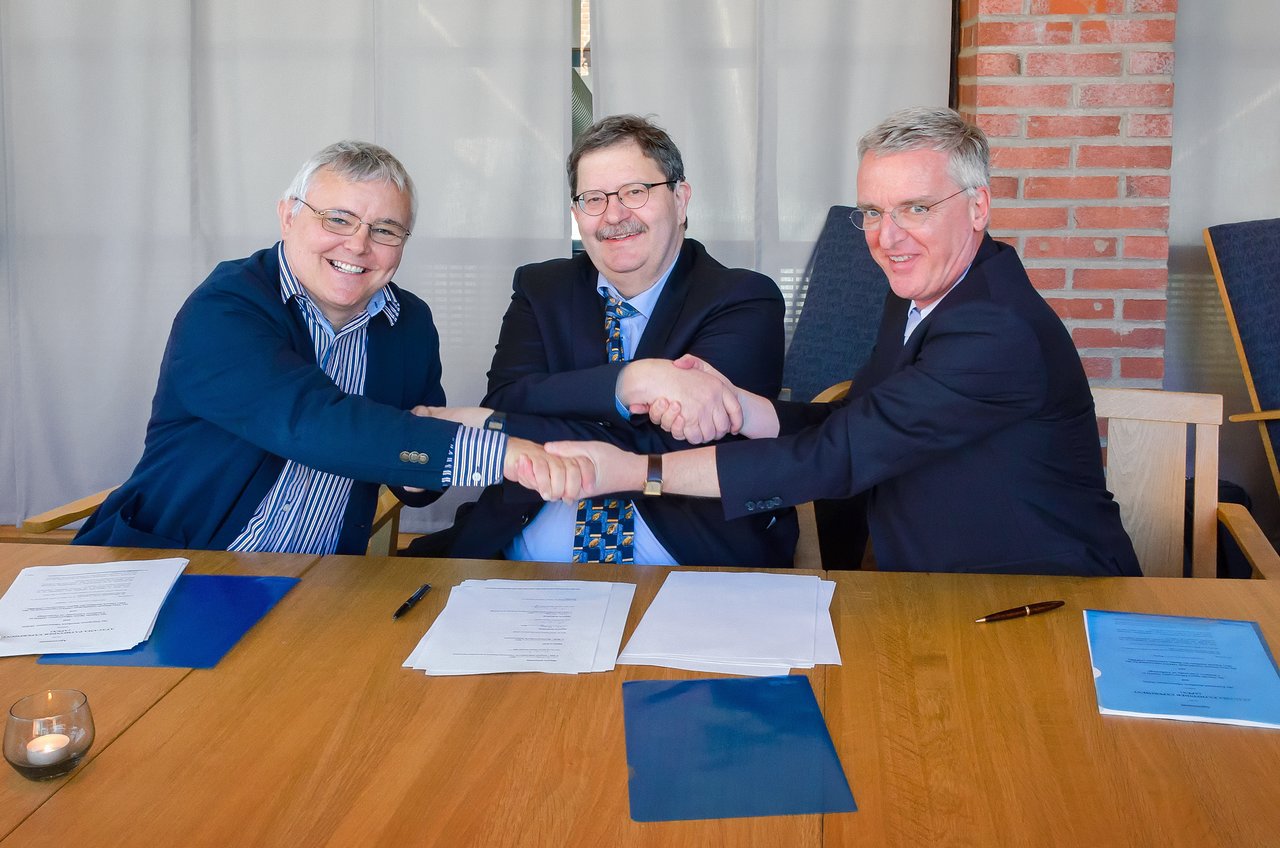 . .
|
|
| David Rabanus has finished his second adventure at APEX. Thanks for your fantastic support and all the best for your future projects! |
|
| It took place the successful workshop "Getting Ready for ALMA Band 5 - Synergy with APEX/SEPIA" at the ESO Headquarters. You can check the details (including speakers and presentations) in the workshop web page |
|
| Mauricio Cardenas re-joined ESO, he is taking part of the Science Operations Group as a TIO. Welcome back, Mauricio !!! |
|
| Mirek Ciechanowicz former MPIfR engineer from sub-mm group, has now joined the APEX project as a member of the engineering group. Welcome to the APEX family! |
|
|
With a great joy, ESO-Chile celebrated the "ESO end-of-the-year Party" at Marriott Hotel in Santiago. A rock concert was performed by APEX band11.
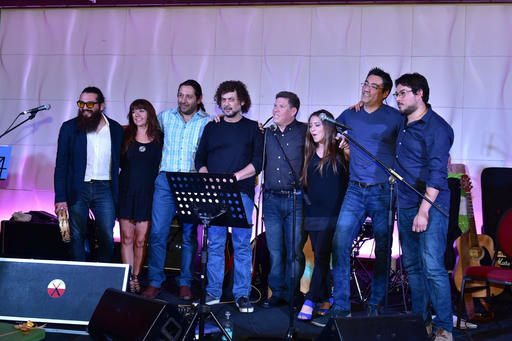 . .
|
|
| Franco Colleoni left ESO, looking for new horizons. Good Luck Franco, we will miss you !! |
| LABOCA photometry mode has been decommissioned and is not offered anymore for semester 2017A (ESO P99) and onwards. The reason is the unreliable results, especially for the very faint sources where it was intended to be used. Users interested in determining fluxes of faint and compact sources should use the mapping mode instead. Please check our LABOCA observing time calculator. |
|
|
It is our sad duty to inform you that Sandor Bintrup passed away on last Friday night, at his home and surrounded by his family.
Beforehand, Sandor had been in hospital where he had been fighting with cancer, however, against all odds. Sandor is one of the APEX pioneers, working for the project since the early days in the construction phase, and he accompanied APEX until his retirement in 2013, at the age of 66. Sandor left his footprint at the project, so that APEX will always be connected with his name. Most of you certainly knew him better than me. I will always keep him in mind as a kind person, always willing to help us, when we came to Apex as visitors. The APEX staff lost a longtime colleague and a good friend. Thank you so much, Sandor! 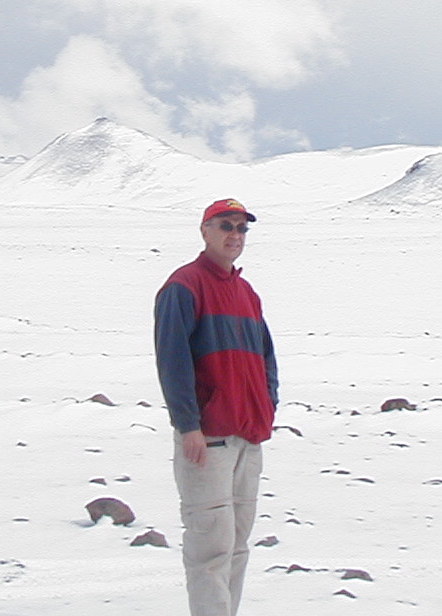 . .
|
|
|
Science with the Atacama Pathfinder Experiment (APEX) 7-9 January 2016 Schloss Ringberg. 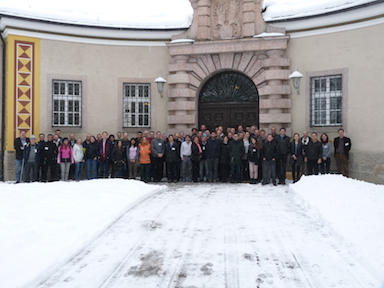 . .
|
|
| ATLASGAL Survey of Milky Way Completed. A spectacular new image of the Milky Way has been released to mark the completion of the APEX Telescope Large Area Survey of the Galaxy (ATLASGAL). More info available at ESO science announcement #1606 |
|
| David Rabanus re-joined the Apex team in February and is supporting the engineering group. Welcome back, David! |
|
| The ATLASGAL survey emission maps and catalogues are now available through the ESO phase-3 interface. Observed at APEX with LABOCA between 2007 and 2010. More info available at ESO science announcement #16008 |
|
| Jorge Ramirez has joined to APEX staff as Electronic Engineer. We wish you a great success Jorge, welcome !! |
|
| Mariano Diaz has joined to APEX staff as Administrator. We wish you a great success Mariano, welcome !! |
|
|
First Observations from SEPIA, the new APEX instrument for finding water in the Universe. A new instrument attached to APEX is opening up a previously unexplored window on the Universe. The Swedish-ESO PI receiver for APEX (SEPIA) will detect the faint signals from water and other molecules within the Milky Way, other nearby galaxies and the early Universe. |
|
|
APEX Open day 2015. The APEX control base in Sequitor opened their gates on October 30th, to share an astronomical evening with the kids and parents participating in the astronomy academy of Liceo "Lican Antai" C-30 San Pedro de Atacama. |
|
|
With a lot of sadness we have to announce: Carlos Duran, our colleague and friend is
leaving us. He will continue his brilliant career in Europe, to get the PhD in Germany.
Our best wishes in your new life. We will miss you !!! 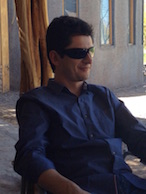 . .
|
|
| Juan Pablo Perez has joined to APEX staff as a astronomer. Welcome Juan Pablo, we wish you the best in this new challenge of your career. |
|
|
Data format specification for APEX sub-millimetre sky maps and LESS phase 3 data release. More info available at ESO science announcement #1537. |
|
|
APEX observations help unravel mystery of Nova Vulpeculae 1670. New observations made with APEX and other telescopes reveal that the star that European astronomers saw appear in the sky in 1670 was not a nova, but a much rarer, violent breed of stellar collision. It was spectacular enough to be easily seen with the naked eye during its first outburst, but the traces it left were so faint that very careful analysis using submillimetre telescopes was needed before the mystery could finally be unravelled more than 340 years later. The results appear online in the journal Nature on 23 March 2015. |
|
| APECS User Manual updated version 3.1 (March 3rd 2015), available here. |
|
|
The new SEPIA (ALMA Band 5) page is available at the APEX web site. |
|
|
ALMA performs its first very long baseline observations with APEX (ann15015 - Announcement). ALMA, the Atacama Large Millimeter/submillimeter Array, has successfully combined its immense collecting area and sensitivity with that of APEX to create a new, single instrument through a process known as Very Long Baseline Interferometry (VLBI). 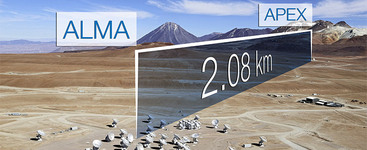 . .
|
|
|
Some changes in our APEX pictures gallery with new pictures too ! |
|
|
Mauricio Martinez has been moved to La Silla Observatory as TIO. All our best wishes to you Mauricio!!. We will miss you Tatin!! |
|
|
The information about the SHeFI calibration issue March - June 2014 was updated and extended. PIs with data from that period: Please read! |
|
| Christian Herrera has joined the APEX team as software engineer. Welcome to APEX Christian !!! |
|
| Karl Torstensson has joined to APEX as staff astronomer. Welcome to APEX Karl !!! |
|
| Francisco Montenegro is the new leader of APEX Science and Operations. Good luck Francisco in your new position |
|
| Fred Schuller has left APEX, Good luck in the future Don Fred. !!! |
|
| After an intensive installation campaign, the SuperCam visiting instrument has been successfully installed at the Cassegrain cabin of APEX. Supercam is a 64-pixel 345 GHz heterodyne array built by the University of Arizona. More info available here. |
|
| Franco Colleoni has joined the APEX team as Electronic Engineer. Welcome to APEX Franco !!! |
|
|
Donation of APEX 1 receiver to PUC. APEX1a, a 230 GHz SIS heterodyne receiver has found a new home: the Centre for Astro-Engineering (AIUC) of the Pontificia Universidad Catolica de Chile (PUC).
APEX1a served as a facility instrument on the APEX radio telescope, in the 1.3 mm band (230 GHz), while a new multi-band instrument was in construction at Onsala (APEX 2a, and later SHeFi). More info available in
this link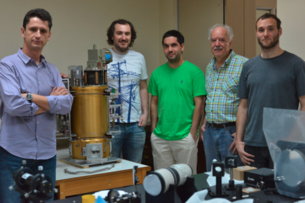 . .
|
|
|
 Una nueva pagina web de APEX en español esta disponible desde este enlace. Una nueva pagina web de APEX en español esta disponible desde este enlace.
|
|
| Construction Secrets of a Galactic Metropolis - APEX reveals hidden star formation in protocluster (ESO Science Release) |
|
| As a result of several both hardware and software interventions to the SHeFI instrument, the antenna temperature T*A applied to the data has been wrongly calibrated between Feb 1st and Jun 13th, to find how to correct the data see the next link |
|
| Rodrigo Olivares has been moved partially to La Silla Observatory, he will share their shifts in APEX and La Silla in the meantime. |
|
| Mauricio Cardenas have left APEX, he will continue his studies in Scotland, UK. We wish you a very good time and success there Mauricio. |
|
| APECS User Manual updated version 3.0 (Revision 3.0, July 21, 2014), available here. |
|
| Carlos Duran assumes as Deputy of the Engineering group. |
|
|
Hidden nurseries in the Milky Way. APEX reveals cradles of massive star-formation throughout our Galaxy. |
|
| APECS User Manual updated version 2.7 (March 5th 2014), available here. |
|
| APEX 2014 Science schedule available here. |
|
|
Science with the Atacama Pathfinder Experiment (APEX) 19-22 January 2014 Schloss Ringberg. 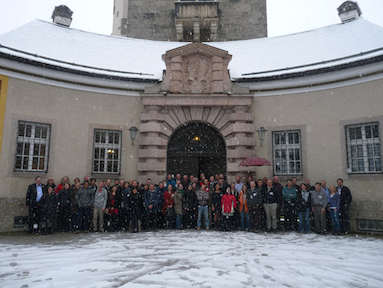 . .
|
|
|
First Light of Powerful New Camera on APEX (eso1341 - Photo Release). A new instrument called ArTeMiS has been successfully installed on APEX. The new camera has already delivered a spectacularly detailed view of the Cat's Paw Nebula. |
|
| Thomas Klein is the new APEX station manager, replacing Gundolf Wieching. |
|
| Orion's Hidden Fiery Ribbon. A dramatic new image of cosmic clouds in the constellation of Orion reveals what seems to be a fiery ribbon in the sky. This orange glow represents faint light coming from grains of cold interstellar dust, at wavelengths too long for human eyes to see. It was observed by the ESO-operated Atacama Pathfinder Experiment (APEX) in Chile. |
|
| The APEX water vapour radiometer is back into operations. PWV data is available from the APEX weather page. |
|
| Edouard Gonzalez has joined the APEX team as telescope and instruments operator. Welcome to APEX Edouard !!! |
|
| Setting the Dark on Fire. A new ESO photo release from the Atacama Pathfinder Experiment (APEX) telescope in Chile shows a beautiful view of clouds of cosmic dust in the region of Orion. While these dense interstellar clouds seem dark and obscured in visible-light observations, APEX's LABOCA camera can detect the heat glow of the dust and reveal the hiding places where new stars are being formed. But one of these dark clouds is not what it seems. |
|
| APEX's Icy Companions featured in the ESO Picture of the week. |
|
| OTF (On-The-Fly) Observing time calculator released and available here. |
|
| We have started to transfer the APEX data to the Archive in Garching via network. This drastically reduces the time between observations being made and data delivery to the PIs. For more information, check this poster presented by F. Montenegro at the APEX Ringberg meeting. |
|
|
APEX takes part in sharpest observation ever - Telescopes in Chile, Hawaii, and Arizona reach sharpness two million times finer than human vision. An international team of astronomers has observed the heart of a distant quasar with unprecedented sharpness, two million times finer than human vision. The observations, made by connecting the Atacama Pathfinder Experiment (APEX) telescope to two others on different continents for the first time, is a crucial step towards the dramatic scientific goal of the Event Horizon Telescope project: Imaging the supermassive black holes at the centre of our own galaxy and others. More info at ESO Organisation Release 1229 |
|
| APECS User Manual (Revision 2.5, April 11th, 2012) released and available here |
|
|
A new image of the region surrounding the reflection nebula Messier 78, just to the north of Orion's Belt, shows clouds of cosmic
dust threaded through the nebula like a string of pearls. The observations, made with the Atacama Pathfinder Experiment (APEX) telescope,
use the heat glow of interstellar dust grains to show astronomers where new stars are being formed. More info at ESO Photo release 1219 |
|
|
ESO Science Release eso1209 - APEX Turns its Eye to Dark Clouds in Taurus. A new image from the APEX (Atacama Pathfinder Experiment) telescope in Chile shows a sinuous filament of cosmic dust more than ten light-years long. In it, newborn stars are hidden, and dense clouds of gas are on the verge of collapsing to form yet more stars. It is one of the regions of star formation closest to us. The cosmic dust grains are so cold that observations at wavelengths of around one millimetre, such as these made with the LABOCA camera on APEX, are needed to detect their faint glow. More info at ESO Science release 1209 |
|
|
ESO Science Release eso1206 - The Wild Early Lives of Today's Most Massive Galaxies - Dramatic star formation cut short by black holes. Using the APEX telescope, a team of astronomers has found the strongest link so far between the most powerful bursts of star formation in the early Universe, and the most massive galaxies found today. The galaxies, flowering with dramatic starbursts in the early Universe, saw the birth of new stars abruptly cut short, leaving them as massive --- but passive --- galaxies of aging stars in the present day. The astronomers also have a likely culprit for the sudden end to the starbursts: the emergence of supermassive black holes. More info at ESO Science release 1206 |
|
| The positions of Claudio Agurto and Felipe Mac Auliffe have changed from Telescope Instruments Operators (TiO) to Observing Specialist (OS) |
|
| Paulina Venegas has joined the APEX team as telescope and instruments operator. Welcome to APEX Paulina !!! |
|
|
The Cool Clouds of Carina: APEX gives us a new view of star formation in the Carina Nebula. More info at ESO1145 - Photo Release |
|
| First announcement of the "Science with the Atacama Pathfinder Experiment" Ringberg meeting is now out. In case of interest, please preregister by sending an email to apex@mpifr.de. |
|
| New version for LABOCA and SABOCA time estimator. The new version are avaible here LABOCA and SABOCA |
|
| Starting with the 1st of August Frederic Schuller has taken up the appointment as APEX staff astronomer. He will take over the responsibilities as head of science operations. Frederic has long record of APEX visits and is known well at APEX. |
|
|
ESO Science Release eso1123 - Hydrogen Peroxide Found in Space.
Molecules of hydrogen peroxide have been found for the first time in interstellar space.
The discovery gives clues about the chemical link between two molecules critical for life:
water and oxygen. On Earth, hydrogen peroxide plays a key role in the chemistry of water and
ozone in our planet atmosphere, and is familiar for its use as a disinfectant or to bleach
hair blonde.
Now it has been detected in space by astronomers using the ESO-operated APEX telescope in Chile.
More info at ESO Announcement 1123 |
|
|
Kiriako Markar has joined the APEX team as the new administrator, taking over the
duties of Ernesto Orrego who is leaving APEX after 6 years. Thanks Ernesto for all of these years of good work and welcome Kiriako to the APEX team! |
|
| New version (2.03-1) of CRUSH is released. Now supports LABOCA and SABOCA photometry mode. Download the new version here. |
|
| The article "The end of star formation in Chamaeleon I ? A LABOCA census of starless and protostellar cores", by A. Belloche, F. Schuller et al., has been accepted for publication on A&A and the preprint is publicly available here. This article is going to be the best reference for reconstruction of faint extended emission in LABOCA data reduction |
|
| Andreas Lundgren is leaving APEX after 6 years working at the science operations group, first as support astronomer and during the last three years as head of the science operations group. Andreas is moving to the ALMA project. |
|
| LABOCA image of Centaurus-A made it on "Best Cosmic Mindblowers of 2010 From Nat Geo News" |
|
| The APEX Telescope Large Area Survey of the Galaxy (ATLASGAL) article was published in the ESO Messenger, available here. |
|
| APEX commemorates the 5th anniversary with the creation of its own facebook page, available here. |
|
| SABOCA calibration data (Zenith opacities and calibration factors) is available on-line |
|
| New BoA version was released (2010 June 24 version). See http://www.eso.org/sci/activities/apexsv/labocasv/ for more information |
|
|
The APEX End-Of-Mission-Report system is online and ready for our visiting observers under this link.
At the end of your observing mission, please take some minutes to evaluate the APEX project. Your feedback will be very much appreciated. Thanks! |
|
| The paper "Intense star formation within resolved compact regions in a galaxy at z = 2.3" has been published in Nature (Nature 21/03) |
|
|
ESO Science Release eso1012 - APEX Snaps First Close-up of Star Factories in Distant Universe.For the first time, astronomers have made direct
measurements of the size and brightness of regions of star-birth in a very distant galaxy, thanks to a chance discovery with the APEX telescope.
The galaxy is so distant, and its light has taken so long to reach us, that we see it as it was 10 billion years ago. A cosmic gravitational lens
is magnifying the galaxy, giving us a close-up view that would otherwise be impossible. This lucky break reveals a hectic and vigorous star-forming
life for galaxies in the early Universe, with stellar nurseries forming one hundred times faster than in more recent galaxies.
More info at ESO Announcement 10/12 |
|
| APECS 2.1 migrated to APECS 2.2 (ACS 8.1 and Scientific Linux 5.3). New functionality in APECS comprises log audiences and 2SB frontend handling. |
|
| The paper "Intense star formation within compact regions in a galaxy seen 3 Gyr after the Big-Bang" has been accepted for publication in Nature. The results published on this paper are partly based upon observations done with APEX and the bolometers LABOCA and SABOCA. Furthermore, the APEX staff members Giorgio Siringo and Andreas Lundgren are among the authors of the paper. |
|
|
APEX featured in the "ESO Highlights in 2009": The Atacama Pathfinder Experiment (APEX) telescope keeps on achieving outstanding results,
such as mapping the dust content of the inner regions of the Milky Way in unprecedented
detail (ESO 24/09)
or imaging the jets and lobes emanating from the central black hole of the active galaxy
Centaurus A (
ESO 03/09). More info at ESO Announcement 10/01 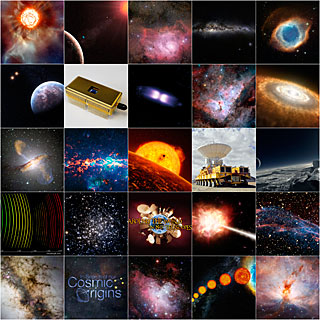
|
|
|
LABOCA Survey of the Extended Chandra Deep Field South (LESS) published in the ESO Messenger. December 2009 (No. 138) |
|
| Oriel Arriagada has joined the APEX team as hardware engineer. |
|
| "ALMA Weather forecast" page linked from the APEX weather page. |
|
|
ATLASGAL: Astronomer's new guide to the galaxy. Largest map of cold dust revealed. More info at (ESO 24/09) |
|
| Giorgio Siringo has joined the APEX team as support astronomer at APEX. |
|
| Alejandra Di Césare has joined the APEX team as support astronomer at APEX for a period of 4 months (July - October). |
|
| Juan Pablo Araneda has joined the APEX team as software engineer. |
|
| New version of the APEX Safety Regulations released. |
|
|
LABOCA paper published and featured as cover page in Astronomy and Astrophysics Vol. 497 No. 3 (April III 2009, pp. 951, 961)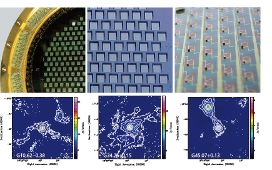
|
|
|
APEX Data on Messenger March 2009 (No.135) cover page. More info at ESO 03/09 |
|
|
Watch the recorded movie of the APEX webcast here.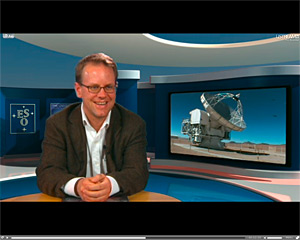
|
|
| APECS 1.1 migrated to APECS 2.0 (ACS 8.0 and Scientific Linux 5.2) and a new control network successfully installed at APEX. |
|
| Black hole outflows from Centaurus A detected with APEX (ESO 03/09) |
|
| Franciso Montenegro has joined the APEX team as support astronomer at APEX. |
|
| VLT and APEX team up to study flares from the black hole at the Milky Way's core ESO 41/08 - Science Release |
|
| APEX reveals glowing stellar nurseries ESO 40/08 - Press release |
|
| SABOCA first light at APEX. |
|
| LABOCA calibration data (Zenith opacities and calibration factors) is available on-line |
|
| Gundolf Wieching has joined the APEX team as RF Engineer in charge of the scientific instrumentation at APEX. |
|
| Andreas Lundgren is the new APEX deputy station manager. |
|
| Call for APEX SABOCA Science Verification. |
|
| Javier Gallardo has joined the APEX team as software engineer. |
|
| Michael Cantzler has joined the APEX team as mechanical engineer. |
|
| APEX data made it to the cover page of A&A for the first time ever. |
|
| APEX data mentioned in the highlights of this week in A&A. |
|
| Andreas Lundgren is the new APEX head of science operations. |
|
| Swedish Heterodyne Facility Instrument (SHFI) Call for Science Verification projects. |
|
| SHFI receivers - Preliminary specifications web page at APEX |
|
| Swedish Heterodyne Facility Instrument Science Verification |
|
| BoA package (2008 January 23 version, 451 kB) |
|
| David Rabanus is the new APEX station manager, replacing Lars Nyman who has moved to the ALMA project. |
|
| Official LABOCA website at MPIfR |
|
| DELTA CALL for the LABOCA bolometer array at APEX |
|
| Call for LABOCA Science Verification |
|
| LABOCA Science Verification Projects |
|
| APEX-2A Science Verification |
|
| Apex Inaguration |
|
| ESO Press Release 18/05 |
